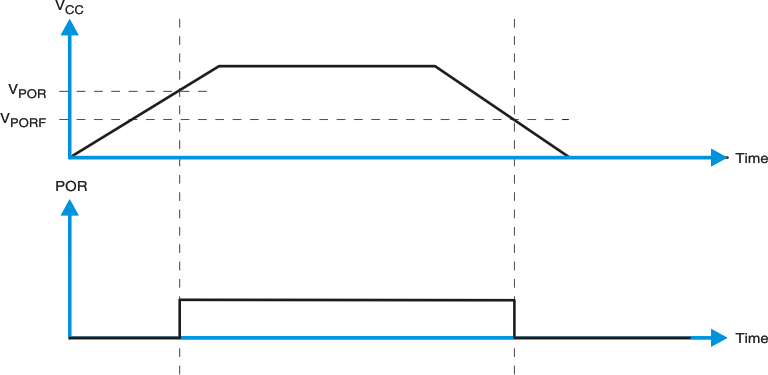SCPS123F March 2005 – January 2015 PCF8575C
PRODUCTION DATA.
- 1 Features
- 2 Applications
- 3 Description
- 4 Revision History
- 5 Pin Configuration
- 6 Specifications
- 7 Parameter Measurement Information
- 8 Detailed Description
- 9 Application and Implementation
- 10Power Supply Recommendations
- 11Layout
- 12Device and Documentation Support
- 13Mechanical, Packaging, and Orderable Information
Package Options
Mechanical Data (Package|Pins)
Thermal pad, mechanical data (Package|Pins)
- RGE|24
Orderable Information
10 Power Supply Recommendations
10.1 Power-On Reset Requirements
In the event of a glitch or data corruption, PCF8575C can be reset to its default conditions by using the power-on reset feature. Power-on reset requires that the device go through a power cycle to be completely reset. This reset also happens when the device is powered on for the first time in an application.
The two types of power-on reset are shown in Figure 20 and Figure 21.
 Figure 20. VCC is Lowered Below 0.2 V or 0 V and Then Ramped Up to VCC
Figure 20. VCC is Lowered Below 0.2 V or 0 V and Then Ramped Up to VCC
 Figure 21. VCC is Lowered Below the POR Threshold, Then Ramped Back Up to VCC
Figure 21. VCC is Lowered Below the POR Threshold, Then Ramped Back Up to VCC
Table 1 specifies the performance of the power-on reset feature for PCF8575C for both types of power-on reset.
Table 1. RECOMMENDED SUPPLY SEQUENCING AND RAMP RATES(1)
| PARAMETER | MIN | TYP | MAX | UNIT | ||
|---|---|---|---|---|---|---|
| VCC_FT | Fall rate | See Figure 20 | 1 | 100 | ms | |
| VCC_RT | Rise rate | See Figure 20 | 0.01 | 100 | ms | |
| VCC_TRR_GND | Time to re-ramp (when VCC drops to GND) | See Figure 20 | 0.001 | ms | ||
| VCC_TRR_POR50 | Time to re-ramp (when VCC drops to VPOR_MIN – 50 mV) | See Figure 21 | 0.001 | ms | ||
| VCC_GH | Level that VCCP can glitch down to, but not cause a functional disruption when VCCX_GW = 1 μs | See Figure 22 | 1.2 | V | ||
| VCC_GW | Glitch width that will not cause a functional disruption when VCCX_GH = 0.5 × VCCx | See Figure 22 | μs | |||
| VPORF | Voltage trip point of POR on falling VCC | 0.767 | 1.144 | V | ||
| VPORR | Voltage trip point of POR on fising VCC | 1.033 | 1.428 | V | ||
Glitches in the power supply can also affect the power-on reset performance of this device. The glitch width (VCC_GW) and height (VCC_GH) are dependent on each other. The bypass capacitance, source impedance, and device impedance are factors that affect power-on reset performance. Figure 22 and Table 1 provide more information on how to measure these specifications.
 Figure 22. Glitch Width and Glitch Height
Figure 22. Glitch Width and Glitch Height
VPOR is critical to the power-on reset. VPOR is the voltage level at which the reset condition is released and all the registers and the I2C/SMBus state machine are initialized to their default states. The value of VPOR differs based on the VCC being lowered to or from 0. Figure 23 and Table 1 provide more details on this specification.
 Figure 23. VPOR
Figure 23. VPOR